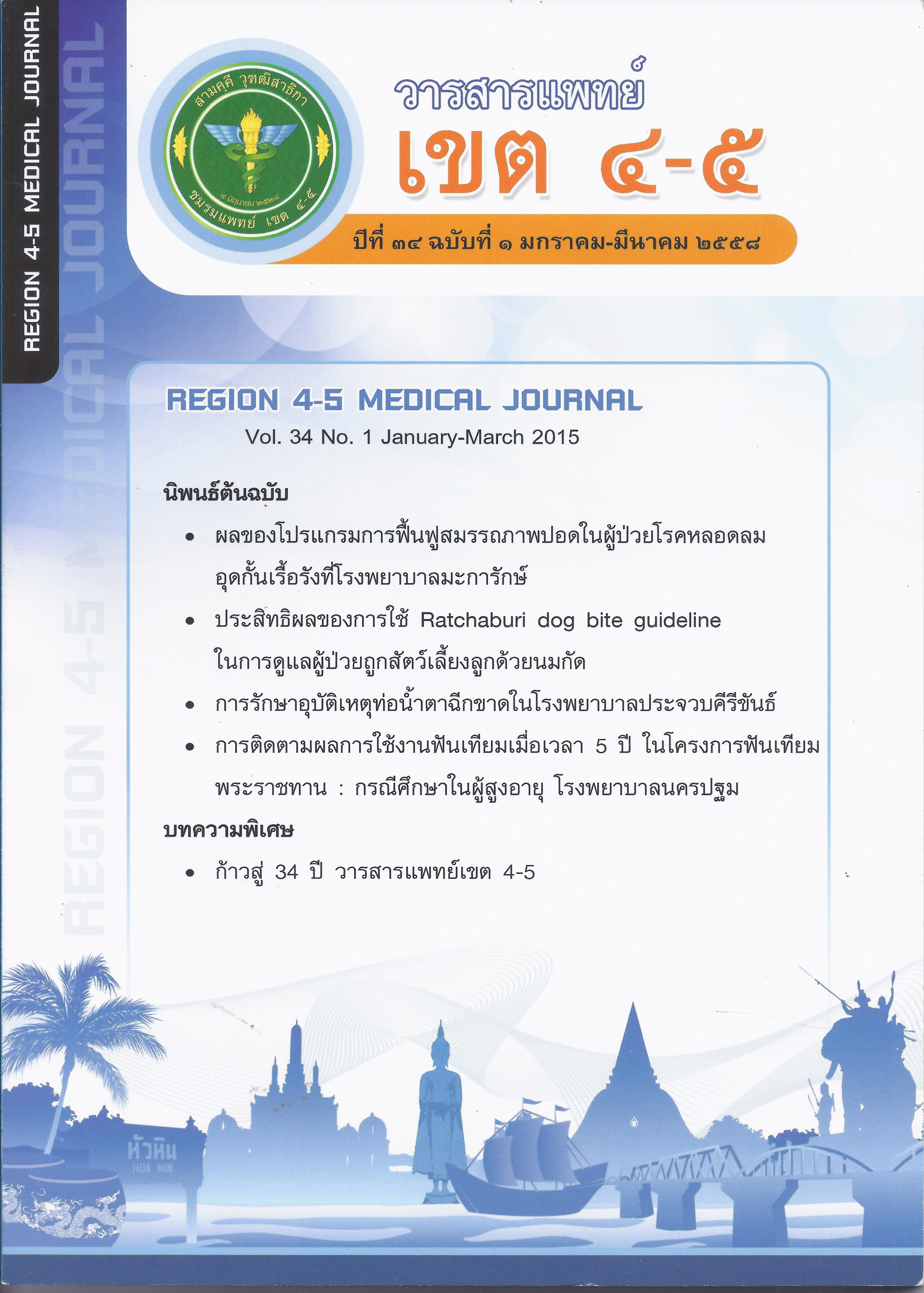การรักษาอุบัติเหตุท่อน้ำตาฉีกขาดในโรงพยาบาลประจวบคีรีขันธ์
คำสำคัญ:
ท่อน้ำตาฉีกขาด, สายท่อน้ำตาบทคัดย่อ
หลักการและเหตุผล : อุบัติเหตุท่อน้ำตาฉีกขาดเป็นปัญหาที่พบได้บ่อยในการบาดเจ็บบริเวณเปลือกตา และใบหน้า (eyelid and maxillofacial trauma) และจำเป็นต้องได้รับการรักษาที่เหมาะสมเพื่อป้องกันการเกิดน้ำตาไหลเรื้อรัง และการระคายเคืองตาในภายหลัง การรักษาภาวะท่อน้ำตาฉีกขาดมีเทคนิค และอุปกรณ์ที่ใช้ในการผ่าตัดที่แตกต่างกัน
วัตถุประสงค์ : เพื่อศึกษาข้อมูลพื้นฐาน อุบัติการณ์ของผู้ป่วยที่ได้รับอุบัติเหตุที่ตาชนิดท่อน้ำตาฉีกขาด และผลการผ่าตัดรักษาท่อน้ำตาฉีกขาดในโรงพยาบาลประจวบคีรีขันธ์
รูปแบบการวิจัย : การศึกษาเชิงพรรณนาแบบย้อนหลัง
วิธีการศึกษา : รวบรวมการบันทึกเวชระเบียนผู้ป่วยที่มีท่อน้ำตาฉีกขาดที่เข้ารับการรักษาที่โรงพยาบาลประจวบคีรีขันธ์ ตั้งแต่วันที่ 1 ตุลาคม พ.ศ. 2553 ถึงวันที่ 30 กันยายน พ.ศ. 2557 โดยเก็บข้อมูลเพศ อายุ ข้างของตาและตำแหน่งของท่อน้ำตาที่ฉีกขาด สาเหตุและปัจจัยร่วมที่ทำให้เกิดการบาดเจ็บ ระยะเวลาก่อนการผ่าตัด เทคนิคการผ่าตัด ระยะเวลาที่ใส่ stent ผลการรักษา และภาวะแทรกซ้อน
ผลการศึกษา : ผู้ป่วยทั้งหมด 54 ราย เป็นเพศชาย 39 ราย (ร้อยละ 72.22) เพศหญิง 15 ราย (ร้อยละ 27.78) อายุเฉลี่ย 38.85 ปี (1-80 ปี) โดยมีสาเหตุของการฉีกขาดของท่อน้ำตาส่วนใหญ่จากอุบัติเหตุรถจักรยานยนต์ 30 ราย (ร้อยละ 55.56) ผู้ป่วยทุกคนได้รับการผ่าตัดรักษาท่อน้ำตาฉีกขาด โดยใช้ probe แล้วใช้ cutdown tube 2.5 Fr จำนวน 41 ราย และ medicut จำนวน 13 ราย เป็น monocanalicular stent การตรวจติดตามให้ผลการรักษาที่ดีคือ ไม่พบอาการน้ำตาไหล หลังเอาท่อออกที่ระยะเวลา 3 เดือน หลังการผ่าตัด
สรุป : การผ่าตัดรักษาท่อน้ำตาฉีกขาดโดยใช้ probe และ cutdown 2.5 Fr เป็น monocanalicular stent ส่วนใหญ่ให้ผลการรักษาที่น่าพึงพอใจ
เอกสารอ้างอิง
2. Jordan DR, Ziai S, Gilberg SM, et al. Pathogenesis of canalicular lacerations. Ophthal Plast Reconstr Surg 2008;24(5):394-8.
3. Nerad JA. Oculoplastic surgery: the requisites in ophthalmology. St. Louis: Mosby; 2001.
4. Ho T, Lee V. National survey on the management of lacrimal canalicular injury in the United Kingdom. Clin Experiment Ophthalmol 2006;34(1):39-43.
5. Forbes BJ, Katowitz WR, Binenbaum G. Pediatric canalicular tear repairs –revisiting the pigtail probe. J AAPOS 2008;12(5):518-20.
6. Liang T, Zhao GQ, Li YL, et al. Efficiency and therapeutic effect of modified pigtail probe in anastomosing lacerated lacrimal canaliculus. Chin J Traumatol 2009;12(2):87-91.
7. Fayet B, Ruban JM. Monocanalicular lacrimal pathway intubation with a stable punctal attachment. In: Guthoff R, Katowitz JA, editors. Oculoplastics and orbit. New York: Springer; 2006. p. 83-8.
8. Naik MN, Kelapure A, Rath S, et al. Management of canalicular lacerations : epidemiological aspects and experience with Mini-Monoka monocanalicular stent. Am J Ophthalmol 2008;145(2):375-80.
9. Della Rocca DA, Ahmad S, Preechawi P, et al. Nasolacrimal System Injuries. In: Weber RK, Keerl R, Schaefer SD, et al, editors. Atlas of lacrimal surgery. New York: Springer; 2007. p. 91-103.
10. Wu SY, Ma L, Chen RJ, et al. Analysis of bicanalicular nasal intubation in the repair of canalicular lacerations. Jpn J Ophthalmol 2010;54(1):24-31.
11. Pan XJ, Mao A, Zhao GQ. Clinical effects of three types of silicone intubations in repairing lacerations of canaliculus. Chin J Traumatol 2009;12(3):173-6.
12. Orhan M, Govsa F, Saylam C. Anatomical details used in the surgical reconstruction of the lacrimal canaliculus: cadaveric study. Surg Radiol Anat 2009;31(10):745-53.
13. Landy JS, Slonim CB, Older JJ. Surgery of the punctum and canaliculus. In: Cohen AJ, Mercandetti M, Brazzo BG, editors. The lacrimal system. New York: Springer; 2006. p. 110-8.
14. Kriangsak Sirirak. A simple lacrimal drainage repair by three- stitch technique without stent in 28 patients at Prapokklao Hospital. Siriraj Med J 2009;61(3):139-42.
15. Weerasak Anutaungkoon. Outcome treatment of canalicular laceration in Khon Kaen hospital. Khon Kaen Med J 2008;32(2):139-46.
ดาวน์โหลด
เผยแพร่แล้ว
รูปแบบการอ้างอิง
ฉบับ
ประเภทบทความ
สัญญาอนุญาต
ลิขสิทธิ์บทความเป็นของผู้เขียนบทความ แต่หากผลงานของท่านได้รับการพิจารณาตีพิมพ์ลงวารสารแพทย์เขต 4-5 จะคงไว้ซึ่งสิทธิ์ในการตีพิมพ์ครั้งแรกด้วยเหตุที่บทความจะปรากฎในวารสารที่เข้าถึงได้ จึงอนุญาตให้นำบทความในวารสารไปใช้ประโยชน์ได้ในเชิงวิชาการโดยจำเป็นต้องมีการอ้างอิงถึงชื่อวารสารอย่างถูกต้อง แต่ไม่อนุญาตให้นำไปใช้ในเชิงพาณิชย์




